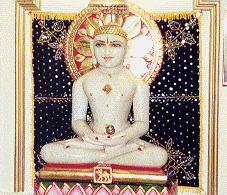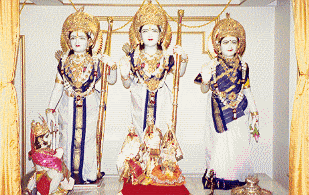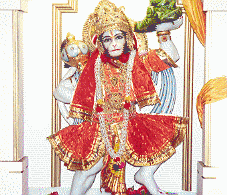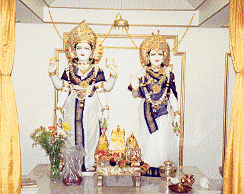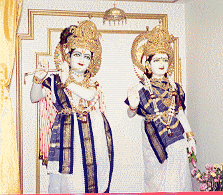|
I visited this temple today, but I called first for the temple hours and puja schedule. When I arrived, I was happy to see that there were more than two cars in the parking lot. The first thing that I noticed different about this temple, compared to the Durga Temple, was that the shoe boxes were inside of the building. Again before entering the main worship hall, I notice Ganesh, the obstacle remover, but instead of a statue, there were painted images of him on the glass doors and windows. In the entry hall, you can smell the incense and hear the chanting inside. Upon entering the hall, the first deity seen to the left of the door is Ganesh, ornamented with flowers, and another deity, painted black and sitting on a peacock. I did not find out about the background on this deity.
I attempted to speak with the other temple priest, but his accent was so thick that I could only catch bits and pieces of what he said, and that was only because they were things that I already understood about the religion (Hinduism). I asked a question about the Jain worship, but missed every bit of his answer. He said that he was about to do a family ceremony and that he could talk after. I watched much of the ceremony in amazement. There were flowers, fruit, gifts, fire, liquids, prasad, bell ringing, and a most impressive display of chanting. A younger gentleman chanted, loud and clear, in this ceremony for most of the 1.5 hours that I was at the temple. Only on a few occasions was he corrected by the priest. As it turns out, the ceremony that I was watching was a thread ceremony. I learned this from the gentleman that came to pick up the other priest. When he first entered the temple, I asked about the ceremony, but he was uncertain. I said it seemed to center around the young boy, and he said it must be the thread ceremony and the young boy must be about to go to school to be come a priest.
In this temple, there are 5 main deities: Krishna [Vishnu?] in the center, Ram and his brother and Sita and Hanuman, Shiva, Durga, and another Krishna and Radha. The walls were decorated with the OM symbol, the Jain symbol some in yellow, some colored red, and a potted plant. Yellow and Red was the main color scheme in the temple. I found out the the plant was the banana plant which represents prosperity and there were two live banana plants in the window. In the image, there was a yellow-orange oval shaped figure in the center of the plant. The gentleman remarked that it was probably a coconut, but I did not get the significance of the coconut.
A number of people entered the temple to attend the thread ceremony. As they did, most of them paid their respects to the deities before attending the ceremony. I noticed a woman walk all the way around the deities (around the side, and around back), return to the front center, kneel and touch her head to the floor. A gentleman circled the deities 3 times and laid his entire body on the floor and touched his forehead to the floor. Some others would turn around in one spot instead of walking all the way around. Of all the worshippers that did this I noticed that the women kneel and the men lay flat on the ground. I wonder why, is it because of the dress that the women wear or just tradition? The gentleman that was still waiting on the priest explained to me that it was part of the tradition to circle the deities and that standing in one spot and turning is like the same thing. Soon the priest was ready for him and they left. I watched more of the thread ceremony and its many parts. It's funny because, every time they rang the bell or got up, I thought it was over, but that only marked another significant part of the ceremony. When the young boy was leighed with several ornamented necklaces, I thought again that was the end of the ceremony... but it wasn't. I don't know how long it actually did last, but I saw 1.5 hours of it and it was amazing to me. And in all that time, the young man that was chanting and commanding did not stop to drink a sip of water. It was a great ceremony and a terrific experience. |
| Created by Laura Ellen Shulman |
Last updated: March 06, 2005
|
